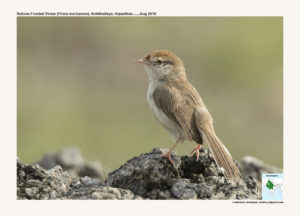Rufous-fronted Prinia

Rufous-fronted Prinia Prinia buchanani
Etymology:
- Prinia : Javanese name Prinyafor the Prinia
- Buchanani : Named after English zoologist Dr Francis Buchanan (1762–1829
Vernacular Names: Sind: Chiho, Guj: Lalbhalnifudki, Lalbhalfadakfutki, Mar: Tambus Dokyacha Vatvatya
Distribution in India: Resident across Central and West India, a few areas in North India
Description: Size of 10-12 cm, wt. of 5-9 g.In Non-breeding plumage it forehead and forecrown rufous, bordered below by whitish Supercilium which diffuses behind eye; upperparts pale brown to grey-brown, wing feathers edged pale grey; tail dark brown, almost blackish on underside, all except central feather pair with conspicuous wide white tips; ear-coverts grey, paling into whitish of underparts; iris yellowish-brown; upper mandible brownish-horn, lower mandible flesh-coloured; legs pale flesh-coloured. In breeding plumage white line above lores disappears, leaving greyish hood, shading darker on lores and ear-coverts; usually has grey band across breast, and grey flanks; bill much blacker, also bright orange orbital ring when in breeding condition. In Breeding plumage the crown is brighter rufous, upperparts warmer brown, except flight-feathers which have conspicuous light grey edges; tail blacker over distal portion on upperside, white feather tips even broader; throat and underparts white, pale apricot wash on lower flanks and undertail-coverts. Both the sexes similar in plumage, female on average a little smaller than male. The juvenile is similar to adult but lacks rufous on crown, has rufous edges of flight-feathers and shorter tail.
Habitat: It is found in Semi-desert plains and foothills with scrub, including dry fields with scattered shrubs, stony semi-desert with coarse grasses and other low plants.
Food Habits: It eats small invertebrates, chiefly insects and their larvae, and small spiders, also eats flower nectar. Usually singly or in pairs. Although not shy, is generally unobtrusive, keeping low in vegetation. Forages close to ground, climbing up stalks or inside bushes, gleaning insects from both leaves and ground. Often forages with mixed parties of small birds, such as various small babblers
Breeding Habits: They breed in June -Sept. The nest is unusually variable in construction, normally an oblong-shaped bag with dome, and opening near top, more rarely an open cup, composed of fine grasses and silky fibers, cup lined with still finer grasses and vegetable down; well-hidden in small thorny bush or clump of grass. They lay a clutch of 4 – 5 eggs